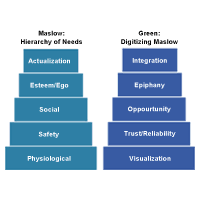Digitizing Maslow
My quest for answers about faculty utilization of IT led to a small epiphany, courtesy of psychologist Abraham Maslow.
We are now well into the third decade of the “computer revolution” in higher education. We began the revolution in the 1980s, asking, “How do we exploit the potential of technology to enhance teaching, learning, instruction, and scholarship?”
As we progress through this third decade, my campus conversations suggest that college presidents, provosts, and campus IT officials, along with campus IT advocates (and even some IT antagonists) are now asking a variation of the original question: “Why don’t more faculty use IT as a resource for teaching, instruction, and scholarship?” Comparing the campus and corporate sectors (always risky for an academic audience), we see significant individual innovation on campus, but also some lag on overall organizational deployment, both in instruction and for campus administration and operations. In contrast, the command-and-control structure of corporations leads to broad operational deployment, but probably less individual innovation.
Yet this seemingly simplistic campus-corporate comparison d'es not explain why, after two decades and billions of dollars for IT in instruction (hardware, software, user support, and instructional development centers), many in and around the campus community are increasingly concerned about the use and impact of technology on instruction. Not surprisingly, we in the campus community are being asked: “Why is it that only 30/40/50 percent of our faculty use IT as an instructional/teaching resource?” and, “Why don’t we have hard evidence about the impact of IT on learning outcomes?”
The impact issues are increasingly important as the
regional accrediting associations move from what might best be called benign
neglect, to active enforcement of the outcome mandates they adopted in the early
’80s. The IT impact question may also become a public policy issue, given the
mandate for “proven methods” and “scientific evidence” of educational impacts
found in the No Child Left Behind legislation affecting K-12 education (www.ed.gov/nclb/methods/whatworks/edpicks.jhtml?src=ln/
).
My quest for answers about faculty
utilization led to a small epiphany, courtesy of psychologist Abbraham Maslow.
Whether you sat or slept through Introductory Psychology as an undergraduate,
there is a good chance that you may remember something about Maslow’s “Hierarchy
of Needs.” Maslow’s hierarchy is one of a number of psychological concepts that
has migrated from academic theory into the common lexicon and helped to
popularize the concept of “self-actualization.”
Maslow’s hierarchy is based on
the theory that needs drive human behavior: We must address or satisfy “basic”
or lower needs before we can address “higher” needs. As described in Maslow’s
own work and summarized on various Web sites, Maslow’s hierarchy identifies five
levels or categories of needs:
1—Basic or Physiological: hunger, thirst,
shelter, sex, etc.
2—Safety: security, protection from physical and emotional
harm
3—Social: affection, belonging, acceptance, friendship
4—Esteem/Ego:
self-respect, autonomy, achievement status, recognition
5—Self actualization:
doing things—doing the right things

Maslow’s hierarchy provides a conceptual
model that has helped me understand the process—the check list, if you will—that
implicitly or explicitly affects the decisions of individual faculty about if,
how, and why to use IT as a resource in instruction.
So it is with great respect
for (and probably apologies to) Abraham Maslow, that I unveil my humble effort
to digitize Maslow’s hierarchy, focused on the faculty experience with IT as an
instructional resource:
1—Visualization: Can I see myself doing this? In other
words, given the way that I teach, the content of my courses, the structure of
my syllabus, and my comfort level with technology, can I actually see
myself—visualize myself—doing something with technology in my classes and my
syllabus?
2—Trust/Reliability: Is the IT infrastructure reliable? Once I decide
to venture into IT with my syllabus, can I trust the campus IT infrastructure
and resources to work for me, not against me (and not embarrass me in front of
my students or my colleagues)?
3—Opportunity: Where is the opportunity to bring
IT into my syllabus? Technology is best viewed as a tool and a resource:
Sometimes it works well, and sometimes it may not make a difference.
Consequently, the choice about technology—if and when to use technology, as well
as how and what to use—really depends on an opportunity to deploy technology
resources, and to do so with some perceived benefit.
4—Epiphany: The leap of
faith from direct experience. Many of us rely on epiphany—personal experience—in
our conversations about the impact of IT on teaching and learning. Additionally,
in the absence of hard statistical data, we fall back on epiphany as the fuel
for our IT efforts, both individual and institutional.
5—Integration:
Recognizing and exploiting IT as an instructional resource. After all,
integration is not the blind faith in any technology, but the selective and
effective use of technology.
Admittedly, like the quest for actualization, the
quest for instructional integration is hard work, for individual faculty and for
institutions. (It also brings to mind an old joke from the software industry:
God could create the world in seven days because there were no legacy systems
and no legacy users!)
Even as campuses add resources to the IT infrastructure
and struggle with support services, the final decisions about information
technology in the classroom and the syllabus are the decisions of individual
faculty (Can I do this? Why should I do this?), not the mandates of campus
officials. Digitizing Maslow’s hierarchy provides a metaphor for the path, as
well as a reminder about the size and scope of the challenge.